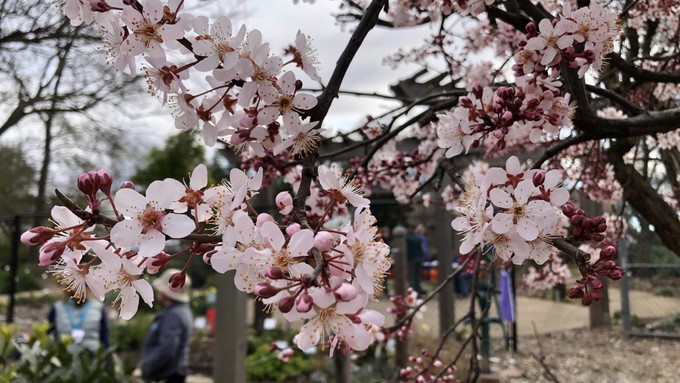
Flavor of oranges may actually get a boost from 'kiss of cold'

Our warmer afternoons have prompted some fruit trees to push out blossoms already, such as on this multi-grafted fruit salad tree, photographed Feb. 11 at the Fair Oaks Horticulture Center. But freezing temperatures could threaten any eventual crop. Kathy Morrison
Our afternoons may feel like spring, but frost danger is still in our forecast. And that creates some challenges for Sacramento-area gardeners: All that tender new growth may need protection.
The National Weather Service warns of “widespread frost” on Thursday and Saturday morning in the greater Sacramento area and foothills. Overnight lows are expected to dip into the low 30s if not below freezing.
Frost threatens not only new shoots but tender blossoms and buds. Sacramento reached 71 degrees on Sunday, Feb. 12. Such warm weather coaxed out early blooms on some fruit trees. Frost can cause those blossoms to fall quickly without setting fruit.
Likewise, frost can burn newly rooted cuttings or transplanted seedlings – even if the temperature stays above 32 degrees. Protect these babies with row covers or “hot caps” – mini-greenhouses made of waxed paper or improvised with plastic milk jugs (with the bottom cut out).
A clear night with no wind can actually produce more frost damage than a windy night at the same temperature. According to university research, foliage temperatures on citrus trees were three to four degrees lower than surrounding air temperature on clear, windless nights. So, 34 degrees could actually feel like 30 to a tender lime or lemon. Young trees are most susceptible to cold damage.
Most citrus is OK down to 30 degrees. Some “chill hours” – time spent under 45 degrees but above freezing – may actually improve the flavor and quality of ripening oranges. That “kiss of cold” brings out the sugars while toughening the skin, extending the fruit’s longevity on and off the tree.
One of the easiest ways to protect sensitive plants: Water. Irrigate your garden before a frost warning; moist soil radiates heat and offers some frost insurance. (The exception are succulents; they soak up that extra moisture and can actually burst if their cells freeze.)
What if a tree or shrub has already suffered frost damage? Leave it on the plant for a few more weeks; it can protect the plant from further damage.
This frost warning is later than usual for Sacramento. After decades of recommending a “last frost” date of mid March, most experts now cut off our frost period at the end of January. According to the Sacramento County master gardeners, our average last frost date is Jan. 27.
But in 2022, Sacramento hit 32 degrees on Feb. 24 and dipped down to 35 degrees on March 6. Our latest ever freeze on record (30 degrees) hit March 27, 1898.
Surrounding communities need to watch out for frost and freeze much later than Sacramento with some areas under threat well into spring. The master gardeners list last frost dates for Marysville (March 16), Lodi (March 31), Woodland (April 1), Auburn (April 13), Davis (April 18), Placerville (May 18) and Nevada City (June 4).
For more tips on frost protection: https://sacmg.ucanr.edu/Frost_Protection/.
Comments
0 comments have been posted.Sacramento Digs Gardening to your inbox.
Sites We Like
Garden Checklist for week of July 21
Your garden needs you!
* Keep your vegetable garden watered, mulched and weeded. Water before 8 a.m. to reduce the chance of fungal infection and to conserve moisture.
* Feed vegetable plants bone meal, rock phosphate or other fertilizers high in phosphate to stimulate more blooms and fruiting. (But wait until daily high temperatures drop out of the 100s.)
* Don’t let tomatoes wilt or dry out completely. Give tomatoes a deep watering two to three times a week.
* Harvest vegetables promptly to encourage plants to produce more. Squash especially tends to grow rapidly in hot weather. Keep an eye on zucchini.
* Pinch back chrysanthemums for bushy plants and more flowers in September.
* Remove spent flowers from roses, daylilies and other bloomers as they finish flowering.
* Pinch off blooms from basil so the plant will grow more leaves.
* Cut back lavender after flowering to promote a second bloom.
* It's not too late to add a splash of color. Plant petunias, snapdragons, zinnias and marigolds.
* From seed, plant corn, pumpkins, radishes, winter squash and sunflowers.